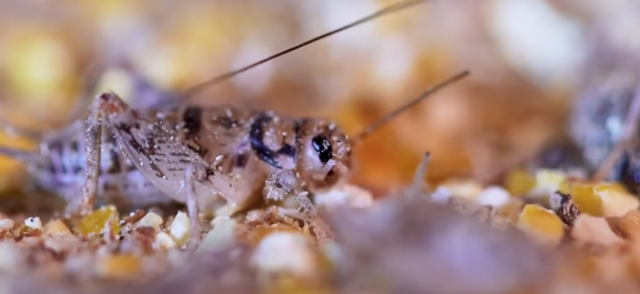Silicon valley is already investing millions in companies producing insect protein, a market valued at over $300 billion dollars. Insects are seen as a sustainable way to feed the growing human population without trashing the planet. Insect protein is getting added to foods people already eat like protein bars, consumer products, bread, pasta and crackers.
Massive Cricket farm
Business Insiders visit to Entomo farms, a cricket farm in Canada, gives an insight into the practices of cricket farming. Quick facts in the video:
- In a single room, 15 million cricket eggs. After 9 days, eggs hatch and stay in the nursery for 2 weeks. From time egg hatches to harvest is 6 weeks, at which time a cricket is fully mature. Its lived out its life, bred and laid eggs, and would be dying within a few days anyway. At which stage, they get turned into food.
- Crickets eat mixture of corn, soy and flax. On average, they feed on a 1,000 pounds (453kg) of feed per day. Such tiny animals consume alot when you have 10-15 million, thats fair amount of feed. It takes a personnel of 5 people to take care of a colony of millions of crickets.
- Among 900 cricket species, Entomo farms chose the tropical house cricket (gryllodes sigillatus) because of its simple feed requirements, does well in high densities, grows really fast and super delicious to eat. Every part of the tropical house cricket is edible, and includes nutrients calcium, iron and fibre.
- Crickets require a nice warm environment, being cold-blooded animals and their metabolism is controlled by temperature. If you keep them on the warmer end of their preffered temperature, they grow faster.
- Crickets eat mixture of corn, soy and flax. On average, they feed on a 1,000 pounds (453kg) of feed per day. Such tiny animals consume alot when you have 10-15 million, thats fair amount of feed.
- Growing 15 million crickets is far more sustainable than farming pigs, poultry or cattle. Crickets contain more protein than beef, without the environmental damage. To produce one kilogram of cow meat takes 22,000 litres of water, and to produce one kilogram of protein from a cricket, takes ca. 850 litres of water.
- Each day Entomo turns 15,000 crickets into 500 pounds of powder. Entomo produces 9,000 pounds of protein per week enough to fill the daily protein requirements of 80,000 people.
- Cricket poop is a usable product, cricket manure. Its called frass, and its a great fertilizer. Farm produces 6,000 pounds of manure per harvest.
- Entomo customers are integrating cricket protein into dog treats, selling it as cricket powder, putting it in a super-food smoothie mix, and putting it into baked goods and snacks. Cricket flour sells for $12 per four ounces
- Challenges: Perception in North America around insect as food is a challenge while in Asia, crickets are already a popular food.
- Benefits: few diseases transferrable from insects to humans which is different from farming mammals and chickens. Crickets have no known viruses or viruses that can cross between species.
In conclusion, massive cricket farming has a number of benefits yet takes up very small space compared to farming poultry and mammals. Cricket farming, just like black soldier fly farming, is sustainable and good for the environment, has no viruses affecting humans and within six weeks, crickets are ready to turn into insect protein that is high demand as an ingredient in human snacks and animal feeds.
Further reading on cricket farming:
What to Feed Crickets. Crickets are omnivores and scavengers. They feed on dry foods such as sunflower seeds, pumpkin seeds, peanuts; and fresh foods like greens (lettuce, broccoli etc), potatoes, carrots, fruits.
Crickets: The food of the future? BBC. Cricket One startup in Vietnam with container setup for farming crickets to produce enough insect protein to feed the world.
Cricket - Diverse facts and history about the cricket. Wikipedia.
Leave us a comment and share the story in your networks.
Read more:


No comments:
Post a Comment
Please do not post SPAM or irrelevant messages. Contribute and spread the spirit of sharing.